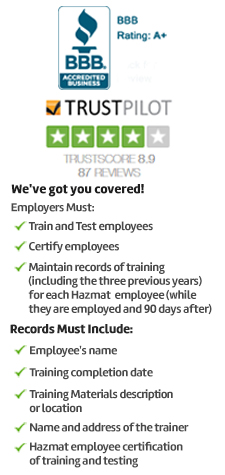
OSHA Forklift Safety Training Course

Enquiry Form
It is a common scene to witness heavy engineering lifting machines such as Forklifts and motorized hand trucks transporting heavy loads of items and machinery from one location to other effortlessly and quickly. However, safety regulations need be followed in operating these heavy lifting machines as these are potentially dangerous vehicles to operate. Without proper training and safety knowledge, accidents can happen which can be fatal at times.
Powered industrial trucks are one of the major causes of accidents on high ways and industrial corridors leading to injuries and death of workers. Injuries can occur when forklifts inadvertently offload unsecured heavy items on workers or hit people or other vehicles nearby while moving from one place to another.
Governing regulations
Our online Powered Industrial Truck safety course has been formulated in-line with OSHA regulations for training requirements as per 29 CFR 1910.178 standards for motorized hand trucks, forklift and powered industrial vehicle operators for initial as well as refresher training.
Course Overview
This online training course focuses on the general safety aspects of high powered industrial trucks with respect to forklifts and other similar load shifting vehicles. Candidates get the clear understanding on the regulations put forth by OSHA’s 29 CFR 1910.178 for handling Powered Industrial Trucks. They also get the explanations of the various safety requirements prescribed by OSHA, hazard identification, risk control and regulatory compliances.
Enquiry Form
Who Must Take this Course?
It is mandatory that all powered industrial truck operators should be trained and certified to operate such vehicles. Only competent and trained drivers must be permitted to drive powered industrial trucks.
Course Format
Our Powered Industrial Truck or forklift safety training course has good quality content provided by safety experts, who have added important case studies, graphical and audio presentations of key topics and self check questions for better preparation for the final exam.
Every successful candidate will be eligible to get a hard copy of completion certificate along with a printable wallet card.
Continuing education credits?
Each of our candidates will get 0.3 CEUs (or 3 CMEs after completing the course.
Topics Covered
- Training Requirements – Operator forklift safety training required by OSHA
- Types and Fundamentals – The differing types and fundamentals of powered trucks
- Operating instructions, warnings, and precautions for the types of truck the operator will be authorized to operate.
- Differences between the truck and the automobile.
- Truck controls and instrumentation: where they are located, what they do, and how they work.
- Operating the Forklift – The basic operating rules and safe work practices
- Engine or motor operation.
- Steering and maneuvering.
- Visibility (including restrictions due to loading).
- Fork and attachment adaptation, operation, and use limitations.
- Vehicle capacity.
- Vehicle stability.
- Any vehicle inspection and maintenance that the operator will be required to perform.
- Refueling and/or charging and recharging of batteries.
- Operating limitations.
- Understanding the Workplace – How workplace conditions can affect safe operation
- Surface conditions where the vehicle will be operated.
- Composition of loads to be carried and load stability.
- Load manipulation, stacking, and unstacking.
- Pedestrian traffic in areas where the vehicle will be operated.
- Narrow aisles and other restricted places where the vehicle will be operated.
- Hazardous (classified) locations where the vehicle will be operated.
- Ramps and other sloped surfaces that could affect the vehicle’s stability.
- Closed environments and other areas where insufficient ventilation or poor vehicle maintenance could cause a buildup of carbon monoxide or diesel exhaust.
- Other unique or potentially hazardous environmental conditions in the workplace that could affect safe operation.

 NEBOSH CERTIFICATE
NEBOSH CERTIFICATE NEBOSH DIPLOMA
NEBOSH DIPLOMA IOSH
IOSH SAFETY DIPLOMA
SAFETY DIPLOMA CPD UK
CPD UK ROSPA UK
ROSPA UK FOOD SAFETY
FOOD SAFETY 



